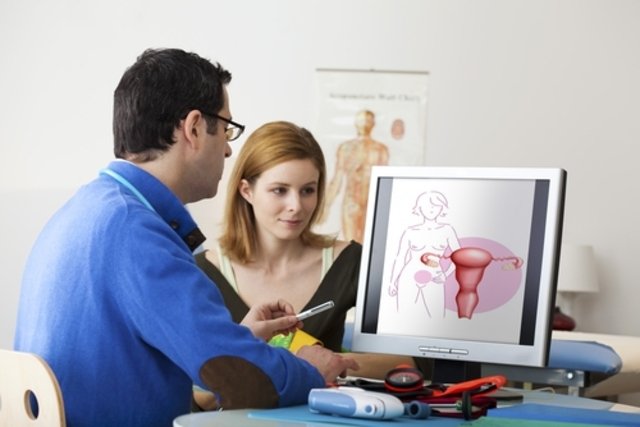The main tests that detect endometriosis are gynecological examination, transvaginal ultrasound, magnetic resonance imaging and measurement of the CA 125 marker in the blood.
However, in cases where the symptoms are very intense, the gynecologist may recommend carrying out tests to assess other parts of the body and thus check the severity of endometriosis.
Endometriosis is characterized by the presence of endometrial tissue, which is the tissue that internally lines the uterus, in places outside the uterus, such as the peritoneum, ovaries, bladder or intestines, for example. Typically, the gynecologist orders these tests when the disease is suspected due to symptoms such as very intense and progressive menstrual cramps, pain during intimate contact or difficulty getting pregnant.
Main exams
The tests that are normally ordered by the doctor to help diagnose endometriosis are:
1. Gynecological examination
A gynecological examination can be carried out in the investigation and diagnosis of endometriosis, and the gynecologist must observe the vagina and uterus with the speculum. Furthermore, depending on the characteristics observed, observation of the rectum may also be carried out with the aim of looking for cysts, which may be indicative of intestinal endometriosis.
2. Pelvic or transvaginal ultrasound
The ultrasound exam is one of the first exams performed in the investigation of endometriosis, and can be pelvic or performed transvaginally. To perform this exam, it is recommended to completely empty the bladder, as this allows you to better visualize the organs.
Ultrasound examination is also very useful in diagnosing ovarian endometriosis, in which endometrial tissue grows in the ovaries, but it can also identify endometriosis in the bladder, vagina and rectal wall.
3. CA 125 blood test
CA 125 is a marker that is present in the blood and whose measurement is normally requested to assess a person’s risk of developing cancer or ovarian cysts and endometriosis, for example, since in these situations the levels of CA 125 in the blood are high. Therefore, when the CA 125 result is greater than 35 IU/mL, it is important for the doctor to request other tests to confirm the diagnosis. See what the CA 125 exam is and how to understand the result.
4. MRI
Magnetic resonance imaging is requested when there is suspicion of ovarian masses that need to be further evaluated, and is also indicated with the aim of investigating deep endometriosis, which also affects the intestine. This examination can show widespread fibrosis and changes in the pelvis, subcutaneous tissue, abdominal wall, and even the surface of the diaphragm.
5. Videolaparoscopy
Videolaparoscopy is the best exam to identify endometriosis because it leaves no doubt about the disease, however it is not the first exam to be carried out, as it is a more invasive exam, in addition to the fact that it is possible to conclude the diagnosis through carrying out other tests.
In addition to being indicated in the diagnosis of endometriosis, videolaparoscopy can also be requested to monitor the evolution of the disease and check whether there is a response to treatment. Understand how videolaparoscopy is performed.
Make an appointment with your nearest gynecologist to recommend tests to help detect endometriosis:
Taking care of your health has never been easier!
Complementary exams
Some complementary tests may also be recommended by the doctor to better observe the severity of endometriosis, such as MRI and rectal endoscopy.
Depending on the extent of endometriosis, the doctor may recommend the use of continuous pills for 6 months, the use of an IUD or surgery to remove the tissue that is growing outside the uterus, which could cause infertility if the pelvic organs are also removed. See how surgery for endometriosis is performed.
Online symptom test
If you think you may have endometriosis, select your symptoms to find out your chances:
The symptom test is only a guidance tool and does not serve as a diagnosis or replace a consultation with a gynecologist.
Bibliography
- NICE. Endometriosis: diagnosis and management. 2017. Disponível em: <https://www.nice.org.uk/guidance/ng73/resources/endometriosis-diagnosis-and-management-pdf-1837632548293>. Acesso em 07 out 2019
- ENDOMETRIOSIS UK. Getting diagnosed with endometriosis. Disponível em: <https://www.endometriosis-uk.org/getting-diagnosed-endometriosis>. Acesso em 07 out 2019
- MAYO CLINIC. Endometriosis: diagnosis & treatment. Disponível em: <https://www.mayoclinic.org/diseases-conditions/endometriosis/diagnosis-treatment/drc-20354661>. Acesso em 07 out 2019

Sign up for our newsletter and stay up to date with exclusive news
that can transform your routine!
Warning: Undefined array key "title" in /home/storelat/public_html/wp-content/plugins/link-whisper-premium/templates/frontend/related-posts.php on line 12
Warning: Undefined array key "title_tag" in /home/storelat/public_html/wp-content/plugins/link-whisper-premium/templates/frontend/related-posts.php on line 13




